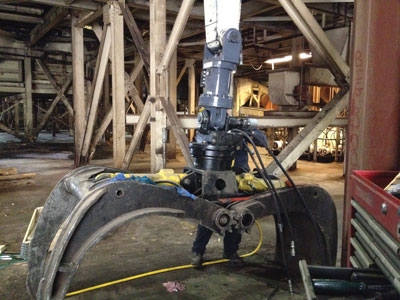
New Gear
Harvesting
New Gear
Improving wood recovery at OSB mill
A wireless grapple scale improves wood recovery program at Norbord OSB mill.
April 9, 2013 By Canadian Forest Industries
 The wireless weighing of the link of the RMT XW grapple scale installs simply by taking the place of the grapple’s original coupler. A wireless grapple scale improves wood recovery program at Norbord OSB mill.
The wireless weighing of the link of the RMT XW grapple scale installs simply by taking the place of the grapple’s original coupler. A wireless grapple scale improves wood recovery program at Norbord OSB mill.“Wood is the number one raw material cost in our product,” says Phillip Starrett at his OSB mill in Joanna, South Carolina. “Every member of our management team looks at these numbers every week.”
Starrett is Norbord’s area manager for the wood room and dryer facility and the numbers he is referring to are the total weights his Tanguay PO460 crane loads into the flaker mill per shift. Access to this data is new for the Norbord team, available only since Starrett had a new XW Series grapple scale installed on the crane.
A better look at wood losses
Running around the clock, Toronto-based Norbord’s Joanna facility produces over 60 million board-feet of OSB (chipboard) every week. Most of the company’s 11 OSB plants process tree-length wood into its finished product but here, at the Joanna mill, logs are cut to 17-foot lengths before they are debarked and loaded into the stranding plant.
Norbord managers knew that the extra steps between unloading and processing resulted in losses of wood that could otherwise be converted into saleable product. Until recently, though, they could only estimate how much wood was lost. As the logs are cut to length, anything under six or seven feet long would fall out and go to waste. Additional losses could mount up with each step from the trucks to the decks, to cutting, debarking and stockpiling.
“We did it the traditional way,” says Starrett. “We just ‘eyeballed’ the log decks to see how much wood we are feeding per shift – count the layers and factor that by the average volume and weight in a layer. Then we could compare that to the weight of the board shipped out at the other end.”
In-motion weighing specialist
The decision to get a clearer picture of losses during the process led Starrett to Daniel Chastenais at Tanguay Machinery, based in Quebec, where the two discussed ways to record precise weights on the grapple without slowing down the loading process. Chastenais came back with a recommendation for the new Intermercato XW Series grapple scale from RMT Equipment, an in-motion weighing solutions specialist, from Laval, Quebec.
“Daniel took care of everything – he tracked down the scale we needed and arranged for the installation.” Starrett recalls. “We really took it on trust – it sounded like the right piece of equipment, with a good warranty to back it up.”
With two of the PO460 cranes onsite, installing the grapple scale required no downtime. The technician from RMT Equipment completed the actual installation in five hours. Since then, Starrett says, each operator has taken about five minutes’ training to learn to work with the scale. The XW Series scale is based on load cell technology that responds to load stresses quickly and accurately. Each unit includes a weigh link and a handheld remote console that receives load data wirelessly from the weigh link’s load cell. The weigh link is installed by simply replacing the standard attachment link on the crane.
Accuracy comparable to truck scale
After six weeks of operation, Starrett says he’s ready to add more grapple scales to his crane fleet. “The Tanguay cranes lift about 5,000 pounds. per load and run over 1,000 tonnes of wood per 12-hour shift,” he reports. “We have one crane operating at a time on a two week cycle, then we rotate it out. I’d like to have the scale on our second Tanguay crane, and we’re also talking to Daniel about a larger scale for the 40-ton crane. Those would give us data from two different points in the log-handling process, so we would get a better picture of where our wood losses occur.”
Starrett says he and his management are pleased with the accuracy of the RMT scale. Operators periodically carry a load over to the plant’s truck scale to compare against the weight shown by the unit. “It’s always pretty close,” claims Starrett.
“Every so often we recalibrate the scale on the crane to match the truck scale. Recalibrating is very quick; maybe eight seconds.” According to Starrett’s calculations, the weights from his grapple scale are within 2% of true weight over the course of a shift. “I expect it would be even more accurate if we weren’t swinging every load through 180 degrees.”
Improved crane efficiency
While the mill’s focus is wood recovery, the grapple scale is also helping operators to get more wood through the mill with the same equipment. Starrett says he can use the scale as a training tool for operators to get a better sense of how much wood the grapple can take in a bite. By keeping an eye on the scale, the operators can get a better feel for the crane and optimize their loads more consistently.
As the Joanna plant’s management team builds it database of log-handling and production weights, the team will be able to look at new wood recovery solutions, with a clear picture of where their investment will make the mill more competitive.
Print this page